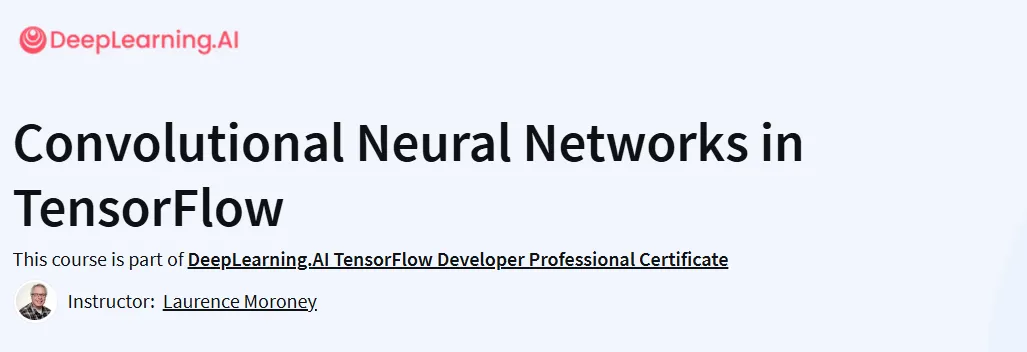What will you learn in this Convolutional Neural Networks in TensorFlow Course
- Build convolutional neural networks (CNNs) using TensorFlow and Keras.
- Handle real-world image data and perform image classification.
- Implement strategies to prevent overfitting, including data augmentation and dropout.
- Apply transfer learning to leverage pre-trained models for new tasks.
- Visualize the journey of an image through convolutions to understand how a computer “sees” information.
Program Overview
1. Exploring a Larger Dataset
⏳ 2 hours
Work with the Cats vs. Dogs dataset, a real-world dataset with images of varying sizes and aspect ratios, to build a CNN that can classify images.
2. Augmentation
⏳ 4 hours
Learn how to implement data augmentation techniques to improve model generalization and prevent overfitting.
3. Dropout
⏳ 4 hours
Understand and apply dropout regularization to reduce overfitting in neural networks.
4. Transfer Learning
⏳ 6 hours
Explore transfer learning by leveraging pre-trained models to improve performance on new tasks with limited data.
Get certificate
Job Outlook
Equips learners for roles such as Machine Learning Engineer, Deep Learning Specialist, and Computer Vision Engineer.
Applicable in industries like healthcare, automotive, robotics, and e-commerce.
Enhances employability by teaching practical skills in building and deploying CNNs using TensorFlow.
Supports career advancement in AI and machine learning domains.
Specification: Convolutional Neural Networks in TensorFlow
|
FAQs
- Basic understanding of Python and machine learning is recommended.
- Prior experience with neural networks is helpful but not mandatory.
- The course introduces CNN concepts from scratch.
- Step-by-step tutorials guide learners through implementation.
- Familiarity with linear algebra and matrix operations is useful but not required.
- Image classification and object recognition.
- Video analysis and action detection.
- Medical imaging and diagnostics.
- Optical character recognition (OCR) and document analysis.
- Self-driving car perception and autonomous systems.
- Includes building CNN models using TensorFlow.
- Real-world datasets are provided for exercises.
- Projects cover end-to-end model training, evaluation, and tuning.
- Learners implement convolution, pooling, and fully connected layers.
- Encourages experimentation with different architectures and hyperparameters.
- CNNs can process sequential data like time series or audio.
- Applicable to text classification using embeddings.
- Useful for signal processing and sensor data analysis.
- Requires adapting CNN architectures for non-image inputs.
- Expands the use of CNNs beyond computer vision.
- Beginners may grasp basic CNNs within 2–3 weeks of consistent practice.
- Advanced architectures and optimization take several months.
- Hands-on projects accelerate understanding.
- Familiarity with TensorFlow and underlying math helps learning faster.
- Continuous experimentation and model tuning reinforce mastery.





